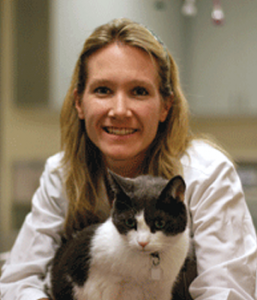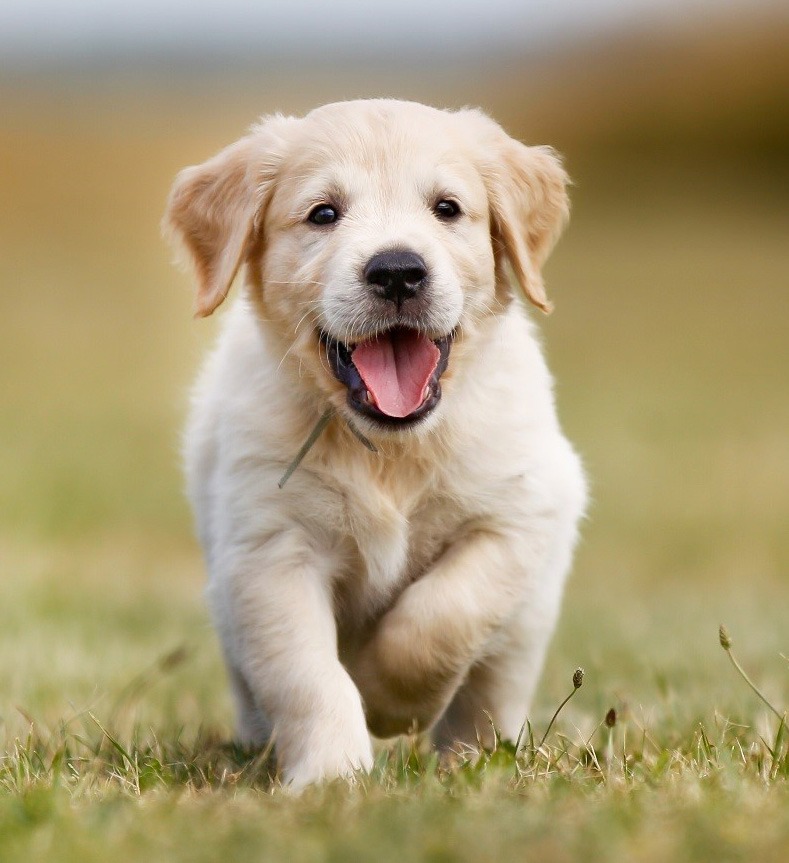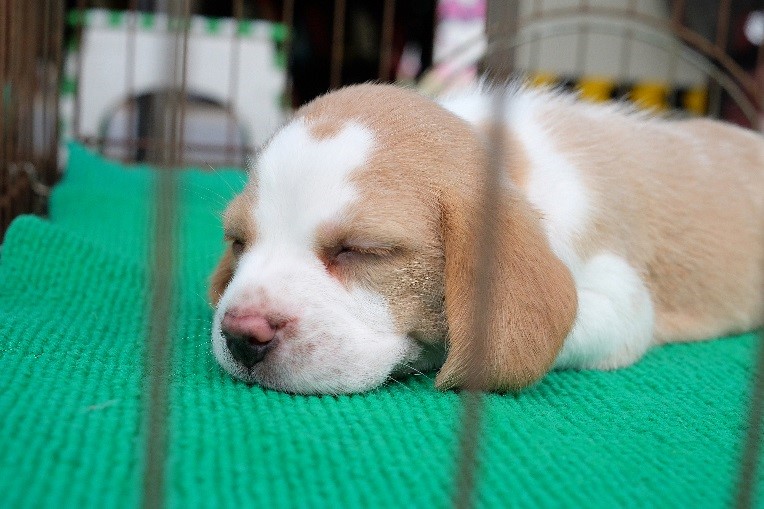-
Adopt
-
Veterinary Care
Services
Client Information
- What to Expect – Angell Boston
- Client Rights and Responsibilities
- Payments / Financial Assistance
- Pharmacy
- Client Policies
- Our Doctors
- Grief Support / Counseling
- Directions and Parking
- Helpful “How-to” Pet Care
Online Payments
Referrals
- Referral Forms/Contact
- Direct Connect
- Referring Veterinarian Portal
- Clinical Articles
- Partners in Care Newsletter
CE, Internships & Alumni Info
CE Seminar Schedule
Emergency: Boston
Emergency: Waltham
Poison Control Hotline
-
Programs & Resources
- Careers
-
Donate Now
 By Lisa Maciorakowski, DVM
By Lisa Maciorakowski, DVM
angell.org/generalmedicine
generalmedicine@angell.org
617-522-7282
Congratulations on your new puppy! Your cute, funny new friend will no doubt bring a lot of joy into your home. In preparation for your new puppy’s arrival and during the first year, there are many things that you can do to help establish the foundation for a happy and healthy life together.
Puppy-Proofing
 Prior to your new puppy’s actual arrival, some “puppy-proofing” should be done. This step shouldn’t be skipped for older dogs, which can be just as mischievous as puppies. All socks and small cat and kids’ toys are just a few of the things that puppies find interesting and whose consumption could potentially lead to a medical emergency. Some foods that should be avoided are chocolate, alcohol, grapes/raisins, onions, garlic, and corn cobs. A list of toxic plants, as well as toxic human foods, can be found on the ASPCA.org website. Similar to child-proofing a home, breakables should be kept out of reach, trash should have covered lids, cords to blinds should be wrapped up, and window screens and doors should be tightly secured.
Prior to your new puppy’s actual arrival, some “puppy-proofing” should be done. This step shouldn’t be skipped for older dogs, which can be just as mischievous as puppies. All socks and small cat and kids’ toys are just a few of the things that puppies find interesting and whose consumption could potentially lead to a medical emergency. Some foods that should be avoided are chocolate, alcohol, grapes/raisins, onions, garlic, and corn cobs. A list of toxic plants, as well as toxic human foods, can be found on the ASPCA.org website. Similar to child-proofing a home, breakables should be kept out of reach, trash should have covered lids, cords to blinds should be wrapped up, and window screens and doors should be tightly secured.
To help your puppy settle in at home during the first several days, keep him in a smaller area of the home at first. This might help make him feel more comfortable and his world can gradually be expanded for supervised exploration. Dog-appeasing pheromones (a natural dog pheromone spray or diffuser) can be used to help keep him relaxed during the transition. Crate training is also encouraged to help keep your puppy safe when you are asleep or away. Many puppies eventually seem to view their crates as a safe and cozy place of refuge. For details on implementing a crate-training routine, you can ask your veterinarian or puppy-school trainer for suggestions or for appropriate sources of information.
House Training
When house-training, the puppy should be brought outside to relieve himself every couple of hours at first and always before and after playing, eating, and sleeping. When the puppy does go to the bathroom in the desired location make sure to have a “party” to celebrate the wanted behavior. Provide positive reinforcement with a treat and/or praise and make much excitement about the job well done.
Socialization
From 7 weeks old to 4 months of age, your puppy goes through a socialization period that permanently shapes his future personality and how he will react to things in his environment as an adult. Gently exposing him to a wide variety of people, places and situations during that time frame makes a huge difference. Be mindful that he will not have completed his full vaccine series, and thus not be completely protected from some diseases. Therefore, it would be best to try to make sure he is interacting with healthy dogs that are up to date on their own vaccines for their age, so as not to miss out on this key socialization window. Training classes are an excellent way to start training your puppy. More than anything, the instructors help train YOU how to train your dog. That is also a good setting to discuss any particular behavioral issues that may arise. These classes are good for early socialization for your puppy….And they are fun!
First Physical Exam, Vaccinations, and Home Care Demonstrations
All newly adopted dogs should be brought to a veterinarian within a couple weeks of adoption for a full physical examination even if they are older and already up to date with their vaccinations. At the visit, your veterinarian can demonstrate some handling techniques for at home care such as nail trimming, checking/cleaning ears, coat brushing and daily teeth brushing technique. Make sure to have a list prepared ahead of time of questions you would like addressed. If you have a purebred puppy you should have researched the breed prior to adoption but you can also discuss with your veterinarian any particular breed health concerns.
Puppies will need to have at least a few visits. They will typically get vaccines at 8, 12, and 16 weeks of age. The particular vaccines will be discussed at the first visit. All dogs will get the core vaccines which are the rabies and “distemper” vaccine (DHPP- distemper, hepatitis, parvo and parainfluenza virus). There are also several elective vaccinations (leptospirosis, lyme, bordetella, influenza). Whether or not these vaccines are given are dependent upon the animal’s lifestyle, environment, health status, and owner’s decision after a conversation with their veterinarian.
Most dogs do great after their vaccines although some sleepiness afterward is common, which may actually be partially attributed to the excitement of the visit as much as a side effect of the vaccine. But just like with humans, it’s always important to monitor for any less common side effects like soreness or sickness. If there is ever any concern about how they are feeling after a vaccine then call your vet or bring them in to be rechecked.
A stool sample should be brought in to the first vet visit so that it can be evaluated for intestinal parasites. Most often a series of deworming medication will be given regardless since parasites are so common. While most parasites are species-specific, there are some that can occasionally affect humans so it is always important to use good hygiene, such as washing hands after picking up after they defecate.
Preventative Options
Dogs can get diseases from fleas and ticks, heartworm disease from mosquitoes, and intestinal parasites from feces. In order to prevent this from happening it is very important to discuss preventative options with your veterinarian. Even dogs that don’t spend a long time outdoors will benefit from these preventatives, which typically come in the form of oral and/or topical medications and collars. Depending on the age of your puppy and history of preventative use prior to adoption a blood test to test for heartworm and tick diseases may be done. When puppies are very young and started on preventatives right away, then this blood test is most often done at the time of the one-year old visit.
Spaying/Neutering
Spaying or neutering is usually done around six months of age (the timing is important to prevent mammary masses in females and prostate issues in males), if not already done prior to adoption. Recent studies are showing that later age neutering is being recommended for certain large breed dogs and can be discussed with your vet. Baseline/pre-surgical blood work is usually recommended, though often not required, prior to spaying/neutering surgery to provide a baseline to which future results can be compared. It will check their kidneys, liver, blood sugar, white and red blood cell counts and electrolytes. When dogs are older it is ideal to do this lab work for yearly monitoring and, of course, anytime they are acting unwell. As with humans, it is also important for your dog to have an exam at least annually.
Microchipping
If your puppy didn’t get microchipped prior to adoption, you can discuss this option with your vet as well. Any lost dog brought into a hospital or shelter will be scanned and if this small metal chip is detected under their skin then they can be reunited with their owner.
Pet Insurance
There are many options for pet insurance. You can research the various companies and see if any of their plans would be of benefit to you. For various costs some plans will cover only sickness or injury while others will also cover wellness visits. They work with you as a third party so that after a vet bill is paid, the paperwork and invoices are submitted to the insurance company to determine what, if anything, can be reimbursed. It is nice that pet insurance is becoming more prevalent as an aid to help with the costs of veterinary care.
Nutrition
A puppy should be fed for their current “life stage.” Therefore, a puppy should be fed a “puppy” food until he is at least a year old. Large breed puppies should be eating food for a “large breed puppy” and are often continued on this puppy food well into their second year. The food should be AAFCO approved and ideally the first ingredient should be a protein source. Dry food may be better for their teeth but also giving some canned food can provide a more interesting variety. More recently, there has become a concern that “grain free” food may be associated with the development of heart disease, so grain free food is discouraged. For the first six months of a puppy’s life the food can be left out or fed as meals several times throughout the day using the rough guidelines on the bag for total amount to be fed each day for your puppy’s weight and age. After that most puppies will need to be started on some sort of portion control/meal feedings to try and keep them from becoming overweight, a very common problem for many dogs. Your vet can help guide your food selection and determine your dog’s BCS (body condition score). Along with food, of course remember to provide your puppy with many fresh, clean water bowls. Treats should be given in moderation and “earned” for good behavior to be used as positive reinforcement associated with training.

Play
Play is a very important part of your puppy’s daily activities. Although it may be tempting, you should not allow them to use any of your body parts as a toy. If he tries to bite your toes or attack your fingers he should be ignored and redirected with an appropriate toy. Any reaction, even a reprimanding one, will be exciting for them and encourage them to persist. Puppies that play hard can be expected to sleep a lot in between playing as well. In an attempt to keep their playtime from coinciding with your night time sleep, you can try to play with them and tire them out earlier in the evening.
Enjoy getting to know the unique personality and quirks of your new puppy. If you were not already a dog person, then you will most certainly be converted into one in no time. Take lots of photos….they grow up fast! Remember that prevention is the best medicine, but most importantly know that your life will be better for having let a dog be part of it.
